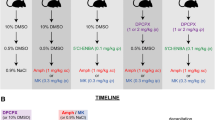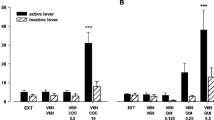Summary
In 24 h reserpine-treated mice, the locomotion induced by the D1 dopamine agonist SKF 38393 (30 mg/kg IP) was facilitated by the NMDA antagonists MK 801 (0.4 mg/kg IP), CPP (1 mg/kg IP), CGP 40116 (1 mg/kg IP) and HA 966 (2 mg/kg IP), and by the AMPA antagonist NBQX (0.2 mg/kg IP). By contrast, CPP, CGP 40116 and NBQX had no effect on, while MK 801 and HA 966 suppressed, the locomotion elicited by the selective D2 agonist RU 24213 (5 mg/kg SC). When these same doses of glutamate antagonists were tested against the locomotion induced by a threshold (0.025 mg/kg SC), intermediate (0.1 mg/kg SC) or large dose (0.5 mg/kg SC) of the mixed D1/D2 agonist apomorphine, CPP, CGP 40116 and HA 966 were found to have no significant effect, whilst MK 801 was strongly inhibitory and NBQX potentiated the response to 0.1 mg/kg apomorphine only. It is evident from these data that the behavioural interaction profiles between glutamate antagonists and dopamine agonists are complex and depend on the receptor selectivities of the drugs concerned. The manner of the interaction between these glutamate antagonists and selective D1 or D2 agonists, is not predictive of the way that blockade of glutamate transmission interferes with the actions of drugs which have combined D1 and D2 motor stimulant properties.
Similar content being viewed by others
References
Bergman H, Wichmann T, DeLong MR (1990) Reversal of experimental parkinsonism by lesions of the subthalamic nucleus. Science 249: 1436–1438
Carlsson M, Carlsson A (1989a) Dramatic synergism between MK-801 and clonidine with respect to locomotor stimulatory effect in monoamine-depleted mice. J Neural Transm 77: 65–71
Carlsson M, Carlsson A (1989b) The NMDA antagonist MK-801 causes marked locomotor stimulation in monoamine-depleted mice. J Neural Transm 75: 221–226
Clark D, White FJ (1987) D1 dopamine receptor—the search for a function: a critical evaluation of the D1/D2 dopamine receptor classification and its functional implications. Synapse 1: 347–388
Crossman AR, Peggs D, Boyce S, Luquin MR, Sambrook MA (1989) Effect of the NMDA antagonist MK-801 on MPTP-induced parkinsonism in the monkey. Neuropharmacology 28: 1271–1273
Davies J, Evans RH, Herrling PL, Jones AW, Olverman HJ, Pook P, Watkins JC (1986) CPP, a new potent and selective NMDA antagonist. Depression of central neuron responses, affinity for [3H]D-AP5 binding sites on brain membranes and anticonvulsant activity. Brain Res 382: 169–173
Domino E, Sheng J (1993) N-methyl-D-aspartate receptor antagonist and dopamine D1 and D2 interactions in 1-methyl-4-phenyl-1,2,3,6-tetrahydropyridine-induced hemiparkinsonian monkeys. J Pharmacol Exp Ther 264: 221–225
Euvrard C, Ferland L, Di Paulo T, Beaulieu M, Labrie F, Oberlander C, Raynaud JP, Boissier JR (1980) Activity of two new potent dopaminergic agonists at the striatal and pituitary levels. Neuropharmacology 19: 379–386
Fletcher EJ, Lodge D (1988) Glycine reverses antagonism of N-methyl-D-aspartate (NMDA) by 1-hydroxy-3-aminopyrrolidone-2 (HA 966) but not by d-2-amino-5-phosphonovalerate (d-AP5) on rat cortical slices. Eur J Pharmacol 151: 161–162
Girault JA, Halpain S, Greengard P (1990) Excitatory amino acid antagonists and Parkinson's disease. Trends Neurosci 13: 325–326
Goodwin P, Starr BS, Starr MS (1992) Motor responses to dopamine D1 and D2 agonists in the reserpine-treated mouse are affected differentially by the NMDA receptor antagonist MK 801. J Neural Transm [P-D Sect] 4: 15–26
Greenamayre JT, O'Brien CF (1991) N-methyl-D-aspartate antagonists in the treatment of Parkinson's disease. Arch Neurol 48: 977–981
Honoré T, Davies SN, Drejer J, Fletcher EJ, Jacobsen P, Lodge D, Nielsen FE (1988) Quinoxalinediones: potent competitive non-NMDA glutamate receptor antagonists. Science 241: 701–703
Hyttel J (1983) SCH 23390 — the first selective dopamine D-1 antagonist. Eur J Pharmacol 91: 153–154
Klockgether T, Turski L (1989) Excitatory amino acids and the basal ganglia: implications for the therapy of Parkinson's disease. Trends Neurosci 12: 285–286
Klockgether T, Turski L (1990) NMDA antagonists potentiate antiparkinsonian actions of L-DOPA in monoamine-depleted rats. Ann Neurol 28: 539–546
Klockgether T, Turski L, Honoré T, Zhang Z, Gash DM, Kurlan R, Greenamayre T (1991) The AMPA receptor antagonist NBQX has antiparkinsonian effects in monoamine-depleted rats and MPTP-treated monkeys. Ann Neurol 30: 717–723
Krebs MO, Desce JM, Kemel ML, Gauchy C, Godeheu G, Chéramy A, Glowinski J (1991) Glutamatergic control of dopamine release in rat striatum: evidence for presynaptic N-methyl-D-aspartate receptors on dopaminergic nerve terminals. J Neurochem 56: 81–85
Lieberman A, Neophytides A, Leibowitz M, Kupersmith M, Pact V, Walker R, Zasorin N, Goodgold A, Goldstein M (1980) The use of two new dopamine agonists: pergolide and lisuride in Parkinson's disease. In: Rinne UK, Klingler M, Stamm G (eds) Parkinson's disease: current progress, problems and management. Elsevier, Holland, pp 335–361
Löscher W, Annies R, Hönack D (1991) The N-methyl-D-aspartate receptor antagonist MK-801 induces increases in dopamine and serotonin metabolism in several brain regions of rats. Neurosci Lett 128: 191–194
Löschmann PA, Lange KW, Kunow M, Rettig KJ, Jähnig P, Honoré T, Turski L, Wachtel H, Jenner P, Marsden CD (1991) Synergism of the AMPA-antagonist NBQX and the NMDA-antagonist CPP with L-DOPA in models of Parkinson's disease. J Neural Transm [P-D Sect] 3: 203–213
Mitchell IJ, Clarke CE, Boyce S, Robertson RG, Peggs D, Sambrook MA, Crossman AR (1989) Neural mechanisms underlying parkinsonian symptoms based upon regional uptake of 2-deoxyglucose in monkeys exposed to 1-methyl-4-phenyl-1,2,3,6-tetrahydropyridine (MPTP). Neuroscience 32: 213–226
Morelli M, Di Chiara G (1990) MK-801 potentiates dopaminergic D1 but reduces D2 responses in the 6-hydroxydopamine model of Parkinson's disease. Eur J Pharmacol 182: 611–612
Morelli M, Fenu S, Pinna A, Di Chiara G (1992) Opposite effects of NMDA receptor blockade on dopaminergic D1- and D2-mediated behaviour in the 6-hydroxydopamine model of turning: relationship with c-fos expression. J Pharmacol Exp Ther 260: 402–408
Rubinstein M, Gershanik O, Stefano FJE (1988) Different roles of D-1 and D-2 dopamine receptors involved in locomotor activity of supersensitive mice. Eur J Pharmacol 148: 419–426
Rubinstein M, Muschietti JP, Gershanik O, Flawia MM, Stefano FJE (1990) Adaptive mechanisms of striatal D1 and D2 dopamine receptors in response to a prolonged reserpine treatment in mice. J Pharmacol Exp Ther 252: 810–816
Schmutz M, Jeker A, Klebs K, Portet C, Pozza M, Fagg GE, Heckendorn R, Allgeier H (1991) CGP 40116/CGP 43487: competitive N-methyl-D-aspartate receptor antagonists with potent oral anticonvulsant activity. Epilepsia 32 [Suppl 1]: 59–60
Seeman P (1981) Brain dopamine recetpors. Pharmacol Rev 32: 229–313
Setler P, Sarau HM, Zirkle CL, Saunders HL (1978) The central effects of a novel dopamine agonist. Eur J Pharmacol 50: 419–430
Starr BS, Starr MS (1986) Differential effects of dopamine D1 and D2 agonists and antagonists on velocity of movement, rearing and grooming in the mouse. Neuropharmacology 25: 455–463
Starr MS, Starr BS (1993a) Comparison of the effects of NMDA and AMPA antagonists on the locomotor activity induced by selective D1 and D2 dopamine agonists in reserpine-treated mice. Psychopharmacology (in press)
Starr MS, Starr BS (1993b) Facilitation of D1 but not D1/D2-dependent locomotion by glutamate antagonists in the reserpine-treated mouse. Eur J Pharmacol (in press)
Starr BS, Starr MS, Kilpatrick IC (1987) Behavioural role of dopamine D1 receptors in the reserpine-treated mouse. Neuroscience 22: 179–188
Svensson A, Carlsson A, Carlsson ML (1992) Differential locomotor interactions between dopamine D1/D2 receptor agonists and the NMDA antagonist dizocilpine in monoamine-depleted mice. J Neural Transm [Gen Sect] 90: 199–217
Wachtel K, Kunow M, Löschmann PA (1992) NBQX (6-nitro-sulfamoylbenzoquinoxaline-dione) and CPP (3-carboxy-piperazinpropyl-phosphonic acid) potentiate dopamine agonist induced rotations in substantia nigra lesioned rats. Neurosci Lett 142: 179–182
Wong EHF, Kemp JA (1991) Sites for antagonism on the N-methyl-D-aspartate receptor channel complex. Ann Rev Pharmacol Toxicol 31: 401–425
Wong EHF, Kemp JA, Priestly T, Knight AR, Woodruff GN, Iversen LL (1988) The anticonvulsant MK-801 is a potent N-methyl-D-aspartate antagonist. Proc Natl Acad Sci 83: 7104
Wüllner U, Kupsch A, Arnold G, Renner P, Scheid C, Oertel W, Klockgether T (1992) The competitive NMDA antagonist CGP 40116 enhances L-DOPA response in MPTP-treated marmosets. Neuropharmacology 31: 713–715
Author information
Authors and Affiliations
Rights and permissions
About this article
Cite this article
Starr, B.S., Starr, M.S. Glutamate antagonists modify the motor stimulant actions of D1 and D2 agonists in reserpine-treated mice in complex ways that are not predictive of their interactions with the mixed D1/D2 agonist apomorphine. J Neural Transm Gen Sect 6, 215–226 (1993). https://doi.org/10.1007/BF02260924
Received:
Accepted:
Issue Date:
DOI: https://doi.org/10.1007/BF02260924




